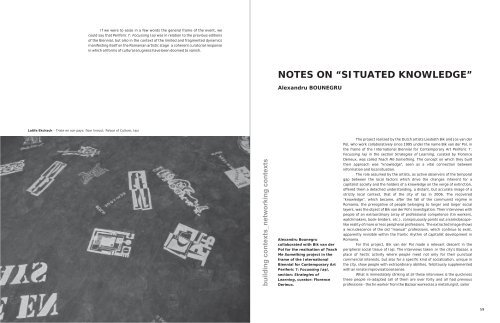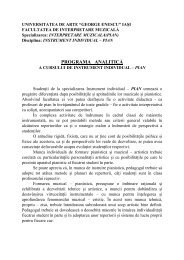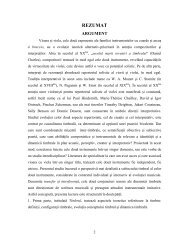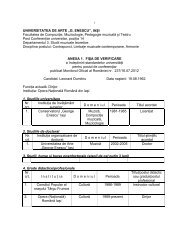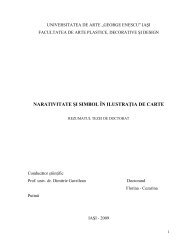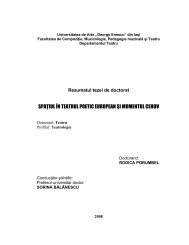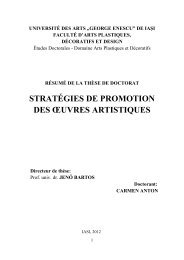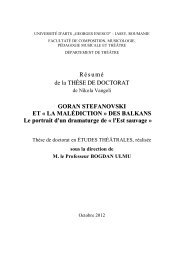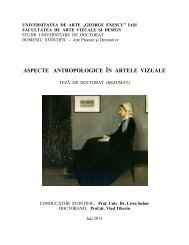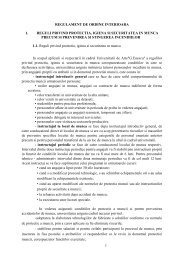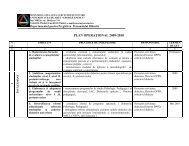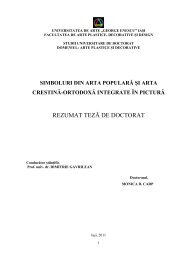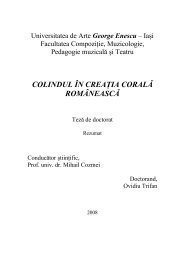vector 2_1.cdr - Universitatea de Arte "George Enescu"
vector 2_1.cdr - Universitatea de Arte "George Enescu"
vector 2_1.cdr - Universitatea de Arte "George Enescu"
Create successful ePaper yourself
Turn your PDF publications into a flip-book with our unique Google optimized e-Paper software.
Latifa Ekchach - Triste en son pays. floor linocut, Palace of Culture, Iaşi<br />
If we were to seize in a few words the general frame of the event, we<br />
could say that Periferic 7: Focussing Iaşi was in relation to the previous editions<br />
of the Biennial, but also in the context of the limited and fragmented dynamics<br />
manifesting itself on the Romanian artistic stage a coherent curatorial response<br />
in which all forms of cultural snugness have been doomed to vanish.<br />
building contexts_networking contexts<br />
NOTES ON “SITUATED KNOWLEDGE”<br />
Alexandru BOUNEGRU<br />
Alexandru Bounegru<br />
collaborated with Bik van <strong>de</strong>r<br />
Pol for the realisation of Teach<br />
Me Something project in the<br />
frame of the International<br />
Biennial for Contemporary Art<br />
Periferic 7: Focussing Iaşi,<br />
section: Strategies of<br />
Learning, curator: Florence<br />
Derieux.<br />
The project realized by the Dutch artists Liesbeth Bik and Jos van <strong>de</strong>r<br />
Pol, who work collaboratively since 1995 un<strong>de</strong>r the name Bik van <strong>de</strong>r Pol, in<br />
the frame of the International Biennial for Contemporary Art Periferic 7:<br />
Focussing Iaşi in the section Strategies of Learning, curated by Florence<br />
Derieux, was called Teach Me Something. The concept on which they built<br />
their approach was “knowledge”, seen as a vital connection between<br />
information and local situation.<br />
The role assumed by the artists, as active observers of the temporal<br />
gap between the local factors which drive the changes inherent for a<br />
capitalist society and the hol<strong>de</strong>rs of a knowledge on the verge of extinction,<br />
offered them a <strong>de</strong>tached un<strong>de</strong>rstanding, a distant, but accurate image of a<br />
strictly local context, that of the city of Iaşi in 2006. The recovered<br />
“knowledge”, which became, after the fall of the communist regime in<br />
Romania, the prerogative of people belonging to larger and larger social<br />
layers, was the object of Bik van <strong>de</strong>r Pol's investigation. Their interviews with<br />
people of an extraordinary array of professional competence (tin workers,<br />
watchmakers, book-bin<strong>de</strong>rs , etc.), conspicuously points out a kaleidoscopelike<br />
reality of more or less peripheral professions. The extracted image shows<br />
a recru<strong>de</strong>scence of the old “manual” professions, which continue to exist,<br />
apparently invisible within the frantic rhythm of capitalist <strong>de</strong>velopment in<br />
Romania.<br />
For this project, Bik van <strong>de</strong>r Pol ma<strong>de</strong> a relevant <strong>de</strong>scent in the<br />
peripheral social tissue of Iaşi. The interviews taken .in the city's Bazaar, a<br />
place of hectic activity where people meet not only for their punctual<br />
commercial interests, but also for a specific kind of socialization, unique in<br />
the city, show people with extraordinary abilities, felicitously supplemented<br />
with an innate improvisational sense.<br />
What is immediately striking at all these interviews is the quickness<br />
these people re-adapted (all of them are over forty and all had previous<br />
professions - the tin worker from the Bazaar worked as a metallurgist, sailor<br />
59


